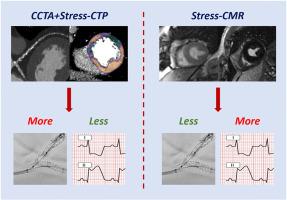STress computed tomogRaphy perfusion and stress cArdiac magnetic resonance for ThE manaGement of suspected or known coronarY artery disease: resources and outcomes impact
IF 5.5
2区 医学
Q1 CARDIAC & CARDIOVASCULAR SYSTEMS
引用次数: 0
Abstract
Background
The aim of this study is to describe resources and outcomes of coronary computed tomography angiography plus Stress CT perfusion (CCTA + Stress-CTP) and stress cardiovascular magnetic resonance (Stress-CMR) in symptomatic patients with suspected or known CAD.
Methods
Six hundred and twenty-four consecutive symptomatic patients with intermediate to high-risk pretest likelihood for CAD or previous history of revascularization referred to our hospital for clinically indicated CCTA + Stress-CTP or Stress-CMR were enrolled. Stress-CTP scans were performed in 223 patients while 401 patients performed Stress-CMR. Patient follow-up was performed at 1 year after index test performance. Endpoints were all cardiac events, as a combined endpoint of revascularization, non-fatal MI and death, and hard cardiac events, as combined endpoint of non-fatal MI and death.
Results
Twenty-nine percent of patients who underwent CCTA + Stress-CTP received revascularization, 7% of subjects assessed with Stress-CMR were treated invasively, and a low number of non-fatal MI and death was observed with both strategies (hard events in 0.4% of patients that had CCTA + Stress-CTP as index test, and in 3% of patients evaluated with Stress-CMR). According to the predefined endpoints, CCTA + Stress-CTP group showed high rate of all cardiac events and low rate of hard cardiac events, respectively. The cumulative costs were 1970 ± 2506 Euro and 733 ± 1418 Euro for the CCTA + Stress-CTP group and Stress-CMR group, respectively.
Conclusions
The use of CCTA + Stress-CTP strategy was associated with high referral to revascularization but with a favourable trend in terms of hard cardiac events and diagnostic yield in identifying individuals at lower risk of adverse events despite the presence of CAD.

用于疑似或已知冠状动脉疾病治疗的应力计算机断层扫描灌注和应力心脏磁共振:资源和结果影响。
背景:本研究旨在描述冠状动脉计算机断层扫描血管造影加应激CT灌注(CCTA + Stress-CTP)和应激心血管磁共振(Stress-CMR)在疑似或已知CAD的无症状患者中的资源和结果:本院连续收治了624名有症状的患者,这些患者的CAD预试验可能性为中到高风险,或既往有血管再通史,转诊至本院接受临床指征的CCTA + Stress-CTP或Stress-CMR检查。223名患者进行了应激CTP扫描,401名患者进行了应激CMR扫描。患者随访时间为指数检查后 1 年。终点为所有心脏事件(血管重建、非致命心肌梗死和死亡的综合终点)和硬性心脏事件(非致命心肌梗死和死亡的综合终点):接受 CCTA + Stress-CTP 检查的患者中有 29% 接受了血管再通治疗,接受 Stress-CMR 评估的受试者中有 7% 接受了有创治疗,两种方法都能观察到较少的非致命性心肌梗死和死亡病例(以 CCTA + Stress-CTP 作为指标检查的患者中有 0.4% 发生了硬性心肌梗死,接受 Stress-CMR 评估的患者中有 3% 发生了硬性心肌梗死)。根据预设终点,CCTA + Stress-CTP 组的所有心脏事件发生率高,而硬性心脏事件发生率低。CCTA + Stress-CTP 组和 Stress-CMR 组的累计费用分别为 1970 ± 2506 欧元和 733 ± 1418 欧元:结论:使用 CCTA + Stress-CTP 策略与较高的血管再通转诊率有关,但在硬性心脏事件和诊断结果方面,尽管存在 CAD,但在识别不良事件风险较低的个体方面,趋势良好。
本文章由计算机程序翻译,如有差异,请以英文原文为准。
求助全文
约1分钟内获得全文
求助全文
来源期刊

Journal of Cardiovascular Computed Tomography
CARDIAC & CARDIOVASCULAR SYSTEMS-RADIOLOGY, NUCLEAR MEDICINE & MEDICAL IMAGING
CiteScore
7.50
自引率
14.80%
发文量
212
审稿时长
40 days
期刊介绍:
The Journal of Cardiovascular Computed Tomography is a unique peer-review journal that integrates the entire international cardiovascular CT community including cardiologist and radiologists, from basic to clinical academic researchers, to private practitioners, engineers, allied professionals, industry, and trainees, all of whom are vital and interdependent members of our cardiovascular imaging community across the world. The goal of the journal is to advance the field of cardiovascular CT as the leading cardiovascular CT journal, attracting seminal work in the field with rapid and timely dissemination in electronic and print media.
 求助内容:
求助内容: 应助结果提醒方式:
应助结果提醒方式:


